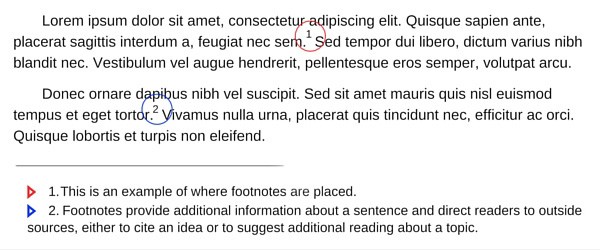Written by Scribendi
While reading a book or article, have you ever noticed little numbers placed at the ends of some sentences?
These numbers usually appear as superscripts and correspond with numbers placed at the bottom of the page, next to which appears further information that is both necessary and supplementary. Sometimes this information will come in the form of citations, but sometimes it will simply present additional notes about the topic at hand.
These citations and explanations are called "footnotes" (because they appear in the footer of the page). Take a look at the example below to see where footnotes appear on a page:

We've outlined how to use footnotes below. Check it out!
1. What Are Footnotes?
2. Footnotes vs. Endnotes
2.1 Should I Use Footnotes or Endnotes?
3. How to Do Footnote Citations
3.1 In-Text Citations
3.2 Footnotes
4. How to Use Footnotes in Essays
4.1 Style Guides
4.1.1 Modern Language Association (MLA)
4.1.2 American Psychological Association (APA)
4.1.3 Chicago Manual of Style (CMS)
5. Technical Guide to Using Footnotes
5.1 How to Add Footnotes in Microsoft Word
5.2 How to Add Footnotes in Google Docs
6. Final Tips and Tricks
1. What Are Footnotes?
Footnotes are notes that are placed at the end of a page and used to reference parts of the text (generally using superscript numbers). Writers use footnotes for several purposes, including citations, parenthetical information, outside sources, copyright permissions, background information, and more.
Now that you understand what footnotes are, you might be wondering: why use them? The truth is, long explanatory notes can be difficult for readers to trudge through (especially when they occur in the middle of a paper). Providing this information is necessary, but doing so in the main text can disrupt the flow of the writing.
Imagine if every time an author wanted to provide a citation, the entire citation had to be written out at the end of the sentence, like this (Anthony Grafton, The Footnote: A Curious History [Cambridge, MA: Harvard University Press, 1999] 221). Books would become much longer and reading would be much more tedious. That's why footnotes are so useful: they let authors provide the required information without disrupting the flow of ideas.
While footnotes are a great resource for sharing information without clogging up the writing, it's important to note that certain style guides restrict when footnotes can be used. We'll get into that soon!
Unsure how to edit your paper? Contact the Scribendi team for professional proofreading.
2. Footnotes vs. Endnotes
Authors can also use endnotes to avoid disrupting their writing with extraneous information. Both serve similar purposes; the main difference lies in their location in your text. Here's a closer look at how both footnotes and endnotes work.
Footnotes:
- Identified in the main text with a small superscript number
- Used for citations, parenthetical information, outside sources, copyright permissions, background information, and more
- Provide the correlating notes at the bottom of the same page
Endnotes:
- Identified in the main text with a small superscript number (like footnotes)
- Used for citations, parenthetical information, outside sources, copyright permissions, background information, and more (like footnotes)
- Found collectively at the end of an article, chapter, or document (unlike footnotes)
2.1 Should I Use Footnotes or Endnotes?
When deciding whether to use footnotes or endnotes, authors must consider three main factors:
- The style guide being used (as some require either footnotes or endnotes)
- The number of notes being included (as having too many footnotes on each page can be distracting)
- Which option will be more convenient for the reader
3. How to Do Footnote Citations
To make a footnote citation, label the area of your text that you need to reference with a number (if it's your first footnote, start with "1."). At the bottom of the page, include this number with the citation. When readers see the number in the text, they know they can find the source by looking for the corresponding footnote.
Here's an example of a quoted piece of text using in-text citations vs. footnotes.
3.1 In-Text Citations
"Like the high whine of the dentist's drill, the low rumble of the footnote on the historian's page reassures" (The Footnote: A Curious History [Cambridge, MA: Harvard University Press], 1999. pg. 1).
3.2 Footnotes
"Like the high whine of the dentist's drill, the low rumble of the footnote on the historian's page reassures."1
[Text continues]
Bottom of the page:
1. The Footnote: A Curious History [Cambridge, MA: Harvard University Press], 1999. pg. 1
4. How to Use Footnotes in Essays
The exact format of your footnote depends on the style guide you're following. Here are some of the most common style guides for writing papers, as well as the footnote rules for each one.
4.1 Style Guides
Of the major style guides, The Chicago Manual of Style (CMS) uses footnotes most often. However, footnotes are occasionally employed in other style guides as well. The main difference is that, while CMS uses footnotes for citation purposes, the Modern Language Association (MLA) and the American Psychological Association (APA) generally rely on them for the provision of additional information.
4.1.1 Modern Language Association (MLA)
While MLA style discourages the use of long footnotes or endnotes, the style guide does permit their use for directing readers to other pertinent information on a relevant subject.
The guide recommends that superscript numbers within the text are placed outside any punctuation that might be present (i.e., after a period if the note is at the end of a sentence and after a comma if the note is at the end of a clause). The exception to this is that the superscript numbers should be placed before dashes.
- When a footnote must be placed at the end of a clause,1 add the number after the comma.
- When a footnote must be placed at the end of a sentence, add the number after the period.2
- Numbers denoting footnotes should always appear after punctuation, with the exception of one piece of punctuation3—the dash.
4.1.2 American Psychological Association (APA)
Like MLA, APA discourages the use of footnotes unless absolutely necessary. Even then, the guide recommends that footnotes only be used to provide content notes (such as providing brief, supplemental information about the text or directing readers to additional information) and to denote copyright permissions. The rules regarding placement of the in-text numbers is the same in APA as in MLA.
4.1.3 The Chicago Manual of Style (CMS)
Of the three main style guides described here, CMS relies on footnotes the most. While CMS does allow the author–date system of in-text referencing (i.e., providing the author's name and the date of publication in parentheses at the end of the phrase, clause, or sentence that references the work), it also offers a citation style in which footnotes or endnotes are employed. In both cases, bibliographies are also required. Whether an author should use the author–date system or footnotes is often decided by the author's professor, journal, or publisher.
As an example, if footnotes are used, the following format should be adhered to when referencing a book in CMS:
Let Us Revise Your Reference Material to Any Style Guide
Try Our Academic Proofreading Service, or Get a Free Sample
5. Technical Guide to Using Footnotes
To use footnotes in your own book, essay, or article, you must first decide on the most appropriate and logical placement of your footnotes in the text. Add numbers according to your chosen style guide, and be sure to add the numbers directly after the phrase, clause, or sentence to which the corresponding footnote refers.
Most online writing programs (such as Microsoft Word and Google Docs) come with easy-to-use tools for inserting footnotes. Here are step-by-step guides to using footnotes in both these programs.
5.2 How to Add Footnotes in Microsoft Word
Here's how to use footnotes in Microsoft Word 2021:
- Click on the place in the text where you want the first footnote to appear.
- Under the References tab, you'll see the following symbol: AB.1. Beneath this symbol is a button with the words, "Insert Footnote." Click it to create your first footnote.
- After you click that button, two numbers should appear: one number should appear in the main text, and the corresponding number should appear at the bottom of the page.
- Write your citation or additional information next to the number that appears in the footer. Format the information according to the rules of your style guide.
- You can easily return to your place in the text by clicking the number at the beginning of the footnote.
Congrats! You've created your first footnote. You can also adjust the footnote settings (like the numbering) by clicking the arrow beside the Footnotes group. It's really that easy!
5.2 How to Add Footnotes in Google Docs
Here's how to use footnotes on Google Docs:
- Click on the place in the text where you want the first footnote to appear.
- Under the Insert tab, click on "Footnotes."
- After you click that button, two numbers should appear: one number should appear in the main text, and the corresponding number should appear at the bottom of the page.
- Write your citation or additional information next to the number that appears in the footer. Format the information according to the rules of your style guide.
All you really have to do to create footnotes is click a button—it couldn't be easier!
6. Final Tips and Tricks
To improve your writing and avoid cluttering the page, you should use footnotes sparingly and only to provide helpful additions or citations. As previously noted, this information may be considered supplementary, which is why it's best to place it away from the main portion of your writing.
When creating your footnotes, always keep reader convenience in mind, and remember that the footnotes are there to convey helpful information. If your footnotes are excessive or unnecessary, readers are likely to become annoyed—they may even be distracted from the main points of your writing.
Now that you're no longer asking "What are footnotes?" and you know how to use them according to various style guides, footnotes can become a great asset to you as a writer. Be sure to follow the recommendations above, as well as those of your preferred style guide, to ensure that you're using footnotes to their best effect. Don't forget—if you ever need help with writing, our academic articles are here for you!
If you need professional proofreading, let Scribendi perfect your writing.
Image source: Daria Nepriakhina/Stocksnap.io
Polish Your Writing with Professional Proofreading
Try Our Academic Proofreading Service, or Get a Free Sample
About the Author

Scribendi's in-house editors work with writers from all over the globe to perfect their writing. They know that no piece of writing is complete without a professional edit, and they love to see a good piece of writing transformed into a great one. Scribendi's in-house editors are unrivaled in both experience and education, having collectively edited millions of words and obtained numerous degrees. They love consuming caffeinated beverages, reading books of various genres, and relaxing in quiet, dimly lit spaces.










